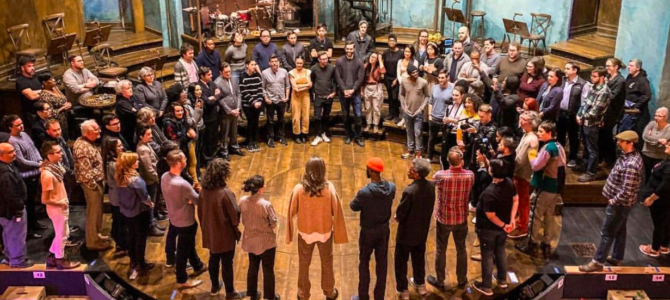
In the ancient stories, we find universal truths. Whether we like them or not, or they jive with who we want to be, is inconsequential. They tell us who we are. They reveal to us where we came from and what we envisioned for our future.
The old tales of love and loss are the last great communique from long-dead ancestors who reached out across the divide of death to give us any understanding that they gleaned of the natural world around them and the inner world of the human heart. Such is the long-told story of Orpheus and Eurydice, lovers separated by death, reunited in hope, destroyed by an inability to trust, retold on Broadway in the musical “Hadestown.”
Written by Anaïs Mitchell, developed with and directed by Rachel Chavkin, the story follows the twisted love stories of both Orpheus and Eurydice and Hades and Persephone, contrasting the story of the young lovers with the seasoned, married pair. The story from Ovid speaks of Orpheus and Eurydice, young lovers and newlyweds, struck with tragedy when Eurydice is bitten by a snake and in death descends into Hades. Orpheus can’t take the grief, and charts a dangerous course through the treacherous pathways into hell’s back door, armed with nothing but song, lyre, and power of musical persuasion.
The Plot of the Best Music Video Ever
It’s basically the basis for the best music video ever. This young man with the power to croon takes up his song and begs the king of the underworld and his queen Persephone to return his beloved to him. So moved are they by his melody and lyrical mastery that they release Eurydice from the bonds of death—under one condition.
She must follow him out of hell, walking the dark and dangerous pathways, not hand in hand nor side by side, but single file, and he must not look back, but trust that she is there behind him, able to make the climb on her own, with his back in her sights, and nothing but the way forward in his.
He agrees—he’d agree to anything—and they set off for the fresh air of earth’s surface. It’s excruciating to not look back. He’s got knots in his stomach the whole way and a tightness in his chest that will not break. He wills himself not to look back, not to make sure she’s there, even though it’s like his heart is behind him, scraping over sharp rocks, dodging whipping brambles, and he’s helpless to protect her.
They’re nearly to the surface when he can’t take it anymore and turns his gaze, only to find that her thread to life is broken along with his promise. She can’t be seen and exist simultaneously, like an ancient Greek uncertainty principle. Ovid (via translation) writes in “Metamorphoses”:
And now they were not far from the verge of the upper earth. He, enamoured, fearing lest she should flag, and impatient to behold her, turned his eyes; and immediately she sank back again. She, hapless one! both stretching out her arms, and struggling to be grasped, and to grasp him, caught nothing but the fleeting air. And now, dying a second time, she did not at all complain of her husband; for why should she complain of being beloved? And now she pronounced the last farewell, which scarcely did he catch with his ears; and again was she hurried back to the same place.
This is the crux of the thing, and the climax in “Hadestown,” and what makes the story one that has lasted since it was written. What is so delightful about “Hadestown” is that it takes this ancient story, the one that made our ancestors laugh and rejoice and weep and all the rest, and brings it into the vernacular of American cultural relevance.
Mitchell sets Orpheus in a little bar with some old New Orleans essence. Orpheus (Reeve Carney) is cast as a shy and awkward bar hand, more in tune with the songs he tries to draw out of his head than to any basic reality. Until he meets Eurydice (Eva Noblezada), the traveler, the girl on her own, whose strength draws him in, and whose strength also is what drives her away from his impracticalities.
In the face of storms and deprivations, he sings. While she scrounges, he sings, stretches to reach the high notes, while she hustles for food and shelter. Unable to find it, she is tempted away from love for security, and descends into Hades of her own free will, something more like suicide than snake bite.
Using Myths as Mirrors
This restating of the myth is one of many retellings over the centuries, and the story is picked up again and again, told from a different character’s perspective, set in a new time and place. These stories that we retell, that we hold up to the light and turn to see all their angles, that we hold up to our time like a mirror, that we look deep within in hopes to glimpse ourselves, are what make us who we are.
For Chavkin and Mitchell, the story is not just one of young love, but plucked from the slim lines of Ovid, or maybe it was in Virgil’s telling, they discovered the story of an older love, that of Hades (Patrick Page) and Persephone (Amber Gray). The original story of Persephone is that she’s a part-time denizen of hell, who every spring ascends to the surface of the earth so that her mother, Demeter, might grace the world with new life, having her daughter once more in her embrace.
Life in hell is not an easy one, and she relishes her time on earth among her friends in the little bar, where she drinks and carouses with Hermes (André De Shields), and hears the music of Orpheus. It’s not just the heat of her husband’s factory fires that make hell so unbearable, but the lost love between them. This is entirely an invention of the “Hadestown” creators, and Persephone is played by Amber Gray with the reality of a woman’s depleted love.
Chavkin came out of the downtown indie theater scene, and is director, writer, and artistic director of New York City-based the TEAM. A developmental theater ensemble, the TEAM created one of my most favorite pieces of theater of all time, “Particularly in the Heartland,” which ran both downtown and in international festivals in the mid-2000s. It was a delight to see elements of the downtown theater aesthetic, from scrappy tech and set concepts to ways the actors create the world with posture and motion and perspective, grace the Walter Kerr stage.
One of the most dazzling lighting displays was directly from the downtown look. Actors of the chorus came in downstage left with some large practicals (lights) shaped like old-time fans you fear children will stick their fingers in, hooked them up to long cables descended from the fly loft, switched them on, then let them swing. This look, of practical lighting elements controlled by actors, were developed in the indie scene entirely because of need.
The big lighting elements, the swivel effects, are expensive. The lighting designers coming out of graduate schools in the aughts were an inventive bunch, unafraid of electric currents, building their own lighting boards, hanging their own grids, making do with $200 (if that) and deep, lasting ingenuity.
“Hadestown” is a map of American references, from blues, second lines, captains of capitalist industry, fates like the gossipy women on the stoop who see and tell all, the showman, the happy agricultural laborers turned un-unionized factory cogs, the distracted genius, and the practical woman who keeps it all together at great cost to her own well-being, the tortured trophy wife who has paid for her diamonds with tears.
Rosy Ideas and Worst Intentions
Chavkin expertly directs all of these into a cohesive visual story, although the play gets a little lost in a political dialectic that attempts to frame capitalism as a net negative against our agrarian past. In looking at the heritage of American labor, it is easy to romanticize the beauty of the fields and the satisfaction of hard work while demonizing the toil of the factory floor. We look at our past with this rosy idea that it was lovely before it was swallowed up by humanity’s worst intentions.
But it wasn’t, it never was. The human story is a constant struggle between doing what’s expedient and doing what’s best, and they overlap and intertwine throughout the ages.
That’s why we need these stories. Not only to guide us, but to let us know that these feelings we have, of loss, of love, of deprivation and fear, are feelings shared with our ancients, with our ancestors, with every grieving widower, with our mothers, and fathers, and the agony they suffered in hustling a future for all of us, just as we’re doing now.
We tell and retell our stories because they are universal, because they give us weight in the world, connection to the earth, and to each other. Despite the best efforts of progressive academia to reframe our oldest stories as biased tales told by dead men, they are lasting, they are relevant, and they will see us through.








